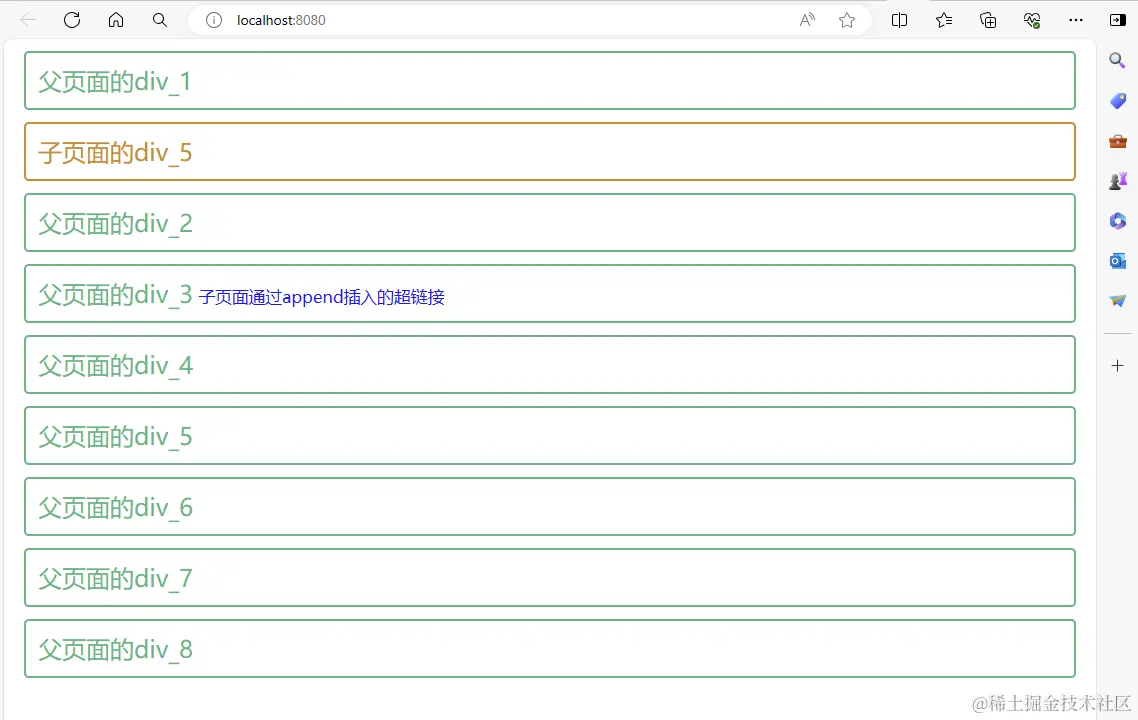前言
问大家一个问题,曾经的你是否也遇到过,一个项目中有好几个页面长得基本相同,但又差那么一点,想用 vue extends 继承它又不能按需继承html模板部分,恰好 B 页面需要用的 A 页面 80% 的模板,剩下的 20% 由 B 页面自定义,举个栗子:

我们假设这是两个页面,B页面比A页面多了个p标签,剩余的东西都一样,难道仅仅是因为这一个 p标签就要重新写一份模板吗?相信大部分伙伴解决方式是把公共部分抽成一个组件来用,这是一个好的做法。没错,但是来了,老板让你在 标题1、标题2下面分别插入一段内容,这会儿你是不是头大了?难道只能重写一份了吗?当然不是,来开始我们的填坑之路~(当你的业务能用插槽或者组件抽离的方式固然更好,以下内容仅针对当你项目达到一定体量,vue老三套难以处理的情况下采用)
准备工作
准备以下工具包:
-
node-html-parser: 将html生成dom树 官网npm install --save node-html-parser
思路
-
子页面提供继承的父页面的路径,如下:
<template extend="./xxx.vue"> </template> -
子页面需要通过一个自定义标签(假设是
<template extend="./xxx.vue">extend)的方式,来决定如何拓展父页面,如下就应该是一个替换的操作,它最少应该具备拓展类型type与目标节点target属性。<extend type="replace" target="#div_1"> 通过replace替换掉父页面下id为div_1的元素 </extend></template>
最终它生成的应该是除了 id 为 div_1元素被<a>通过replace替换掉父页面下id为div_1的元素 </a>替换掉之外,剩下的全部和xxx.vue一样的页面。
梳理需求点
子页面继承父页面既可以完全继承,也可以通过某种方式以父页面为基板,对其进行增、删、改。方便理解,我们先定义一个自定义标签 extend,子页面通过该标签对其继承的页面操刀动手术,为了实现一个比较完善的继承拓展,extend 标签需要具备以下属性:
Extend Attributes
| 参数 | 说明 | 类型 | 可选值 |
|---|---|---|---|
| type | 指定扩展类型 | string | insert(插入)、replace(替换)、remove(移除)、append(向子集追加) |
| position | 指定插入的位置(仅在 type 取值 insert 时生效) | string | before(目标前)、after(目标后) |
| position | 指定插入的位置(仅在 type 取值 append 时生效,用于指定插入成为第几个子节点) | number | - |
| target | 指定扩展的目标 | string |
实现需求
新建一个vue2的项目,项目结构如下:
 我们的继承拓展通过
我们的继承拓展通过自定义loader在编译的时候实现,进入到src/loader/index.js
javascript
const extend = require('./extend');
module.exports = function (source) {
// 当前模块目录
const resourcePath = this.resourcePath;
// 合并
const result = new extend(source, resourcePath).mergePage();
// console.log('result :>> ', result);
// 返回合并后的内容
this.callback(null, result);
};实现继承拓展主要逻辑代码:src/loader/extend.js
javascript
const parser = require('node-html-parser');
const fs = require('fs');
const pathFile = require('path');
/**
* 通过node-html-parser解析页面文件重组模板
* @param {String} source 页面内容
* @param {String} resourcePath 页面目录
* @returns {String} 重组后的文件内容
*/
class Extend {
constructor(source, resourcePath) {
this.source = source;
this.resourcePath = resourcePath;
}
// 合并页面
mergePage() {
// 通过node-html-parser解析模板文件
const pageAst = parser.parse(this.source).removeWhitespace();
// 获取template标签extend属性值
const extendPath = pageAst.querySelector('template').getAttribute('extend');
if (!extendPath) {
return pageAst.toString();
}
// extendPath文件内容
const extendContent = fs.readFileSync(pathFile.resolve(pathFile.dirname(this.resourcePath), extendPath), 'utf-8');
// extendContent文件解析
const extendAst = parser.parse(extendContent).removeWhitespace();
// 获取页面文件标签为extend的元素
const extendElements = pageAst.querySelectorAll('extend');
extendElements.forEach((el) => {
// 获取对应属性值
const type = el.getAttribute('type');
const target = el.getAttribute('target');
const position = parseInt(el.getAttribute('position'));
// 匹配模板符合target的元素
let templateElements = extendAst.querySelectorAll(target);
// type属性为insert
if (type === 'insert') {
templateElements.forEach((tel) => {
// 通过position属性判断插入位置 默认为after
if (position === 'before') {
el.childNodes.forEach((child) => {
tel.insertAdjacentHTML('beforebegin', child.toString());
});
} else {
el.childNodes.forEach((child) => {
tel.insertAdjacentHTML('afterend', child.toString());
});
}
});
}
// type属性为append
if (type === 'append') {
templateElements.forEach((tel) => {
const elNodes = el.childNodes;
let tlNodes = tel.childNodes;
const len = tlNodes.filter((node) => node.nodeType === 1 || node.nodeType === 3).length;
// 未传position属性或不为数字、大于len、小于0时默认插入到最后
if(isNaN(position) || position > len || position <= 0){
elNodes.forEach((child) => {
tel.insertAdjacentHTML('beforeend', child.toString());
});
}else {
tlNodes = [...tlNodes.slice(0, position-1), ...elNodes, ...tlNodes.slice(position-1)]
tel.set_content(tlNodes);
}
});
}
// type属性为replace
if (type === 'replace') {
templateElements.forEach((tel) => {
tel.replaceWith(...el.childNodes);
});
}
// type属性为remove
if (type === 'remove') {
templateElements.forEach((tel) => {
tel.remove();
});
}
});
// 重组文件内容
const template = extendAst.querySelector('template').toString();
const script = pageAst.querySelector('script').toString();
const style = extendAst.querySelector('style').toString() + pageAst.querySelector('style').toString()
return`${template}${script}${style}`
}
}
module.exports = Extend;好的,自定义loader已经编写完成,在vue.config.js里面配置好我们的loader
javascript
const { defineConfig } = require('@vue/cli-service')
module.exports = defineConfig({
configureWebpack: {
module: {
rules: [
{
test: /\.vue$/,
use: [
{
loader: require.resolve('./src/loader'),
},
],
},
],
},
},
})接下来我们尝试编写A页面和B页面:
javascript
<template>
<div class="template">
<div id="div_1" class="div">父页面的div_1</div>
<div id="div_2" class="div">父页面的div_2</div>
<div id="div_3" class="div">父页面的div_3</div>
<div id="div_4" class="div">父页面的div_4</div>
<div id="div_5" class="div">父页面的div_5</div>
<div id="div_6" class="div">父页面的div_6</div>
<div id="div_7" class="div">父页面的div_7</div>
<div id="div_8" class="div">父页面的div_8</div>
</div>
</template>
<script>
export default {
name: 'COM_A',
props: {
msg: String
}
}
</script>
<style scoped>
.div {
color: #42b983;
font-size: 1.5em;
margin: 0.5em;
padding: 0.5em;
border: 2px solid #42b983;
border-radius: 0.2em;
}
</style>B.vue:
javascript
<template extend="./A.vue">
<div>
<extend type="insert" target="#div_1" position="after">
<div id="div_child" class="div">子页面的div_5</div>
</extend>
<extend type="append" target="#div_3" position="2">
<a> 子页面通过append插入的超链接 </a>
</extend>
</div>
</template>
<script>
import A from './A.vue'
export default {
name: 'COM_B',
extends: A,//继承业务逻辑代码
props: {
msg: String
}
}
</script>
<style scoped>
#div_child {
color: #d68924;
font-size: 1.5em;
margin: 0.5em;
padding: 0.5em;
border: 2px solid #d68924;
}
a {
color: blue;
font-size: 0.7em;
}
</style>我们在App.vue下引入B.vue
javascript
<template>
<div id="app">
<B/>
</div>
</template>
<script>
import B from './components/B.vue'
export default {
name: 'App',
components: {
B
}
}
</script>
<style>
#app {
font-family: Avenir, Helvetica, Arial, sans-serif;
-webkit-font-smoothing: antialiased;
-moz-osx-font-smoothing: grayscale;
text-align: center;
color: #2c3e50;
margin-top: 60px;
}
</style>当我们执行编译的时候,实际上B.vue的编译结果如下:
html
<template>
<div class="template">
<div id="div_1" class="div">父页面的div_1</div>
<div id="div_child" class="div">子页面的div_5</div>
<div id="div_2" class="div">父页面的div_2</div>
<div id="div_3" class="div">
父页面的div_3
<a> 子页面通过append插入的超链接 </a>
</div>
<div id="div_4" class="div">父页面的div_4</div>
<div id="div_5" class="div">父页面的div_5</div>
<div id="div_6" class="div">父页面的div_6</div>
<div id="div_7" class="div">父页面的div_7</div>
<div id="div_8" class="div">父页面的div_8</div>
</div>
</template>
<script>
import A from './A.vue'
export default {
name: 'COM_B',
extends: A,//继承业务逻辑代码
props: {
msg: String
}
}
</script>
<style scoped>
.div {
color: #42b983;
font-size: 1.5em;
margin: 0.5em;
padding: 0.5em;
border: 2px solid #42b983;
border-radius: 0.2em;
}
</style>
<style scoped>
#div_child {
color: #d68924;
font-size: 1.5em;
margin: 0.5em;
padding: 0.5em;
border: 2px solid #d68924;
}
a {
color: blue;
font-size: 0.7em;
}
</style>注意我们在B.vue使用了extends继承了组件A,这里是为了能复用业务逻辑代码,最后我们运行代码,页面输出为:

结语
在真实的项目当中,我们遇到大量重复的页面但是又有小区别的页面,是可以通过这种方式减少我们的代码量,当然也许有更好的办法,也希望大伙能提出宝贵的建议。
最后引用一下 @XivLaw 老哥的评论:有很多人说通过cv就能解决,但是当你的业务有成千上万个页面是趋同,并且具有相同的基本功能,当界面需要统一调整或者需要进行ui统一管控的时候,cv就成了你的累赘了。 也有朋友说通过组件化和插槽解决,组件化是一个不错的方案,但是当成千上万个趋同的界面存在时,插槽并一定能覆盖所有的业务定制化。 使不使用这种方式,主要看你的业务。
直白一点说就是:我现在有一千个页面几乎一样,有的页面是头部多一点东西,有的是底部,有的是某个按钮旁边多一个按钮,有的是输入框之间多个输入框,ui或者界面或者同时需要添加固定功能,需要调整的时候,这一千个页面要怎么调?
仅供参考!!!